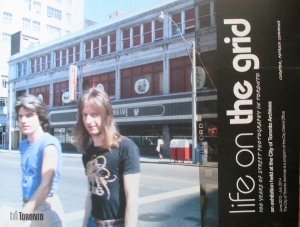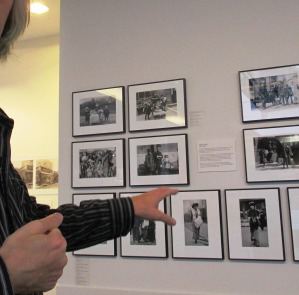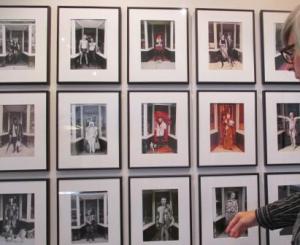Whenever images are organized into a set the meaning of each is subtly altered. Each time we meet a person on the street we see them in a slightly different way. In the constantly transforming city the same nondescript, out of the way location presents a different appearance from one year to the next.
I interviewed archivist Patrick Cummins this week about his curating of Life on the Grid and how it connected with his work as a photographer who produces images of the same places over the span of many years to create an in-depth visual archive.
You are an artist who documents the streets of Toronto. How did this inform why and how you created this exhibition?
My work focuses almost exclusively on built form and what that tells us about our history in terms of the accumulation of stories on the surfaces of things. It doesn’t focus on people; however, they may be present peripherally or in their absence through the details of the structures that say things about them.
I wanted to do an exhibit that featured people in every photograph. That’s in stark contrast to my work but it’s also in stark contrast to the usual form of exhibits here. Usually our exhibits tell a story, illustrate something or give answers to common questions. They are organized around themes or typical historical narratives. This is not the case here.
I wanted people to ask questions about how photography interacts with people on the streets by showing different forms of street photography. This exhibit judges images here in the archives by modern definitions of this practice. The context is the prevalence of social media and digital photography.
It offered a chance to review favourite collections like William James or Arthur Goss, to bring forward lesser known people like Ellis Wiley or Michel Lambeth and present for the first time Ivaan Kotulsky, our most recently acquired material.
The exhibit spans a period that pre-dates street photography as a defined approach and asks how photography in the 1800s, given the lack of easily portable equipment and required exposure length, matches up with the immediacy of modern street photography. Over a hundred years later, with Kotulsky everything is very active and fluid. He’s right at the end of analog photography in the nineteen nineties; his work is at the transition point into digital.
Kotulsky’s work was made during a down time for street photography. The heyday of street photography, its first boom was in the 1910’s and 20’s in Europe and then in the 1950’s, 60’s and 70’s in the U.S. When he is doing this work in the 1980’s and 90’s, it was not a popular approach in terms of what was being shown in galleries.
So you’re talking about street photography as part of art photography. Does the popularity of street photography in popular culture coincide with its popularity with artists?
Generally speaking, yes. It generally fell out of favour. The work that was being shown in galleries was more conceptual in that period. But with the birth of digital photography and social media it’s eclipsed everything else.
In terms of this exhibit as a reflection of our holdings—there’s the dichotomy between what’s produced in terms of government doing its business and what we’ve acquired to give people a big picture of the history of Toronto. So you have both government generated images and privately produced images playing back and forth throughout the show.
All photographs at the archives are part of an illustration of Toronto.
That’s right. There’s another dichotomy with one end being an approach informed by art and the other the non-art, like the government images, and then everything in between. So you get that sort of interaction between photography for art and photography for journalism. We sort of say that there are two or three things that make something photojournalism and two or three things that make it art but there’s always going to be an interplay.
With somebody like Lambeth, the photojournalism is informing his work but this particular body of work is far more artistically driven than most of what he did. This is a personal project documenting the streets of Toronto, working class Toronto and its gathering places like St. Lawrence Market. The focus is also on children in the city. It’s very dark, moody work. It sort of exceeds what you would generally think of as photojournalism.
By contrast, James, working half a century earlier, is far more playful in his approach. He is working within the framework of photojournalism because he’s trying to sell these images to papers. A lot of what he does is to taken “on spec” that he’s going to sell it. He would go out and document a subject in a manner that would play up the human element. His images are so focused on people, as were Lambeth’s, but the mood is very different.
But a lot of these urchin images were produced with a very serious agenda of drawing attention to the conditions of the city. The kiddies in them embody an appeal to the readers of The Star in the context of programs or funds for which the paper was advocating.
But this is what I’m pointing out here—this sort of playfulness. It’s hard to tell how real or how staged the image is.
So that’s something that distinguishes the photojournalistic attitude towards the creation of images from the more art driven attitude?
You would think so. But then again, with Goss, who was strictly a documentarian within a government framework would allow these sorts of things to happen in his images that don’t need to be there for the purpose of the document, but he allows them for whatever reasons.
He’s a functionary documenting city infrastructure to expose problems with such things as housing?
Sometimes, but not always, in the case of the Housing Series it’s all about the state of repair of the buildings, it’s not about the people. Whereas, ten fifteen years earlier, the focus of the Health Department Series was the health of people and the state of the buildings was secondary. The former was driven by the Medical Officer of Health and the latter by higher levels of government driving housing reforms needed due to deteriorating infrastructure.
But it’s all the work of the same photographer, Arthur Goss?
Yes, he works for the department of Public Works but he’s being asked for documentation by different departments, each series has a different focus.
But through this exhibit you’re saying that the aesthetic value of these images and the conceptual aspect of these practices transcend the agenda of the people who sent him out to document the city. Is that right?
Given the passage of enough time and the absence of the original documentation in terms of why and how the images were produced, you can pretty much add anything to them—if the images are strong enough.
Is that your role as the curator?
My role in this show is to elicit the questions; your job is to come up with the answers!
Is this an art exhibition at the archives?
This isn’t an art exhibition per se. It’s just another way of presenting our images that hopefully leads to a lot of questions.
However, we do have materials, holdings that have come in from artists. In this case Peter Sramek who heads up the photography program at OCAD University. In terms of the pantheon, if you want, Sramek and Lambeth might be considered artists whereas the rest are not necessarily there.
So they’re working within an art world discussion of ideas about photography?
Well with Lambeth it’s been applied to him afterwards. He’s selling stories to newspapers like James was but in a different time and in a different way. Sramek himself is creating portfolios that are coming out of the photojournalistic tradition but he’s creating more defined portfolios within the gallery context.
Beyond collecting them for their documentary value, the archives maintains the artistic integrity of Sramek’s work by presenting them within the sets in which they were assembled?
That’s right. For example, these are from two different portfolios, a portfolio being a specific set of images defined by the artist. The individual images and the order are defined. The top one is “the male image,” the bottom one,” the sexual revolution”. At the same time, these images provide substantial documentation of “big bad Yonge Street” just before the clean-up in the seventies. With time the images will take on more documentary value than originally appreciated.
That’s a good segue-way to the balloon man who I saw physically here at the archives and whose photo is featured on the cover of the archives’ annual report.
His image is part of the work of two business men who were working in the sixties and seventies in offices downtown but they had a passion for photography and a feel for the city. With Ellis Wylie it’s about specific types of people, with E.R. White it was more about a neighbourhood, Kensington, the Yonge street mall. They went out in their spare time and took pictures of people in streets during a period when a lot of photographers were restricting themselves to documenting buildings.
My interest in the William James collection is to connect individual images to their captioned published form as news a hundred years ago. In tracking them back I’ve realized how those images were part of a visual code, just being developed through popular press, to discuss contemporary concerns about city life. I guess that marks them as photojournalism as distinct from the work of these two amateur, documentary photographers. However, just as with the reprise of Lambeth images in the context of art, I’m beginning to appreciate how James interpreted his photos under different criteria when he set about organizing them as sequences for his magic lantern shows .
By the way,with such an iconic subject such as the balloon man, beyond collecting his image as part of the iconography of street photography what is the role of the archives in documenting him as a subject in Toronto history?
I believe that he was being interviewed when you saw him here last week. So many of those that appear in street photographs remain anonymous, like the balloon man has until now, even with recent material like Kotulsky’s from the 1990s, …if you walked down Queen Street West now, there may be one or two of those people still contributing to the “visual fabric” of the street but most are gone.
Kotulsky didn’t make any real distinctions between street people and people on the streets. Everyone was photographed with the same approach, the person walking by or the person working on the street, living nearby, out shopping, the squeegee kids, the street musicians, whatever. He loved to pose people in the same doorway; giving everyone the same frame was a way of leveling and unifying all his subjects. It’s very easy with a camera to be judgmental.
So the frame distances the viewer from the individual subject and its repetition levels all of the subjects within a sequence?
That’s one way that he avoided the problem of the judgmental camera. The other way was repeated encounters with the same people. A lot of street photography is hit and run. The only interaction between the photographer and the subject is that brief second when they snap the picture of you in passing. In this approach there’s much more interaction and it’s over a longer period of time so you get a fuller picture of the subject. It’s actually a rare thing in street photography to build up a rapport like that and it’s because he was working out of one fixed location for a specified period of time. It really lends something extra to the work and makes it less exploitative than most street photography can be.
Is that why people are reticent to indulge in street photography?
It becomes more and more difficult. With the dramatic increase in street photography resistance to it escalates. “Don’t take my picture. Get away from me.” The more something happens the greater the reaction to it. While it can be very difficult to produce street photography imbued with sensitivity, that doesn’t mean there aren’t many great examples out there of sensitive work being done, like Kotulsky’s
How has the internet and the Flikr photo stream made you see your work in a different light?
The thing about it is that it’s a great way to get people to look at your work. You’re not restricted by the need to narrow and freeze things down in a way that is palatable to the gallery, so that they invest in showing it. With Flikr you’re free to show your work as you shoot it, it’s a stream of consciousness, you can throw your images in the flow.
So, Flikr is like an enormous river Ganges of images, a kind of cosmic flow that you’re contributing to with your own discrete tributary, a running commentary on Toronto’s ever-changing changing built form. But the Coach House Press book that came out a few years ago doesn’t capture the vitality of your photography in that light.
Yes, however, the book pulls the separate images of those structures together so that you get to appreciate them as static forms.
Yes, I can see that.
Thanks Patrick.
Life on the Grid, 100 Years of Street Photography in Toronto can be seen at the City of Toronto Archives, 255 Spadina Road. It has been held-over into fall 2014. Admission is free.












